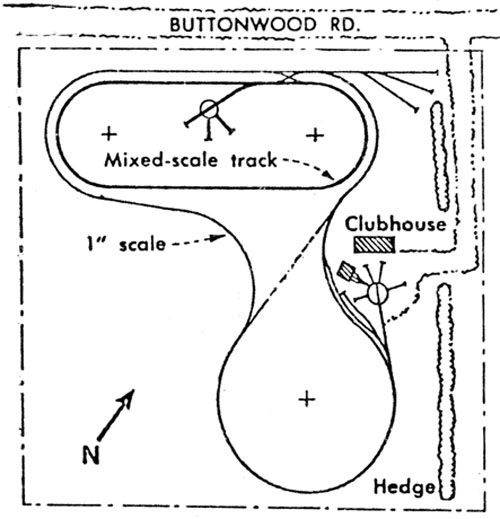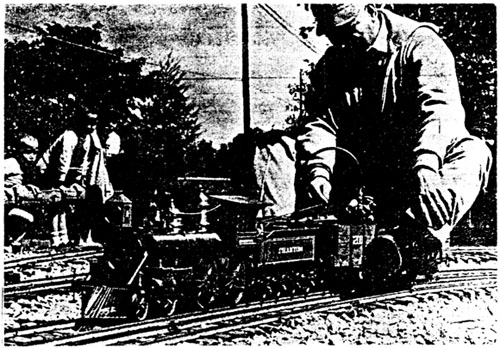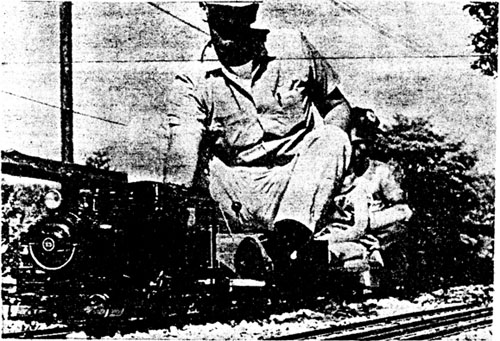|
Home : Quarterly Archives : Volume 18 |
Tredyffrin Easttown Historical Society |
|
Source: April 1980 Volume 18 Number 2, Pages 55–60 When the Big Apple Line Ran in Easttown Township The "Big Apple Line", a railroad more properly identified as the Paoli, Leopard & Sugartown, operated for twenty-four years in an old, abandoned orchard on the south side of Buttonwood Road, just west of its intersection with Darby-Paoli Road in Easttown Township. The three and a half acre site was rented from its owner, Kenneth Souser, for one dollar a year. Although the line was only 1890 feet long in all, at a scale of one inch to the foot it was the equivalent, at full size, of more than four and a third miles of track. The original track, an oval 650 feet around, was constructed to accommodate locomotives and rolling stock of 1/2", 3/4" and 1" gauge; a connecting loop of over 1200 feet of track was later added for 1" scale trains only. The mixed gauge section of track, in the old orchard, was known as the Big Apple Division; the connecting loop, on ground sloping upward to the south, was called the Mountain Division, The two divisions converged at Asparagus Corners curve, and the interchange connection between the two divisions was an imposing "scissors" crossover along the Buttonwood Road side of the layout. The PL&S was operated by the Pennsylvania Live Steamers. The club, founded in 1946, in point of continuous operation is the second oldest live steam club in the United States and the oldest surviving one in the East. (Live steam clubs were first started at the end of the nineteenth century in England.
The layout of the Pennsylvania Live Steamers in Ken Souser's orchard While there had been several model railroad organizations of this type in this country, including several in Philadelphia of which some of the pioneer members of PLS were at one time members, all but one of these has since discontinued operations.) In attendance at the inaugural founding meeting of the club, held in January 194-6 at the home of Karl Layer in Strafford, were Layer, Joe Wilson, J. Harold Geissel, George White, David Torrance, Percy Pierce, Howard E. Thomas, and Stewart Book. Wilson was elected president of the organization, and Torrance was named treasurer. By the end of the year, five more members had joined the Live Steamers: George Thomas, Frank Moore, Ken Souser, Lee Scott, and William Marple. Surprisingly, relatively few of the club!s members ever worked for a full-sized railroad. They came from all walks of life: Layer, for example, was a milk company executive; Geissel was an architect; George Thomas was a mechanical arts teacher; Souser, a labor relations attorney. But they all were railroad buffs, interested in building detailed scale model live steam locomotives and in constructing an operating track on which to run them. The first task the new club faced was to find a site on which to lay a track. Its solution came about in a chance conversation on the Paoli Local one day shortly after the club had been formed. The occasion has been recalled by Adrian "Doc" Buyse, one of the early members of the Pennsylvania Live Steamers. "Daily commuting companions on the Paoli Local to the city, Souser and Geissel," he noted, "had ample opportunity to discuss their mutual railroad hobby interests. It was at this juncture that Geissel mentioned the founding of a live steam club earlier in the year, and the quest for a track location. Souser, previously unaware of the live steam interest on the Main Line, and immensely interested in the future possibilities offered by the new organization, immediately suggested, 'Why don't you fellows put up your track in my orchard!' Thus Souser1s PLS association began, as both genial host and a longtime member. With this unparalleled offer at hand, in the summer of 1946 the new club accepted Souser's generosity speedily." Buyse also recalled, "Although the track site was [thus] assured, there was no unamity among the pioneers as to its precise location on the property. Some argued for its siting up on the slope, a distance somewhat removed from Buttonwood Road. In the end, the track was located along the road, to provide a vantage point for spectators along the split-railed fence." The problem of track acquisition was similarly fortuitously solved, by the purchase from the Penrose family of the track of a model railroad that had been built in 1929 in a horse pasture on the Penrose estate of Church Road between Devon and Berwyn. As noted in the first annual report of the club, for $100 the club was able to buy all the rails, some 7000 feet of heavily galvanized steel rail in all, about 2500 cypress ties, a turntable, and bridge timbers. Over the Labor Day weekend, they were dismantled and moved to the Souser's barn for storage. The balance of the fall was spent in surveying the property to set the location for the layout and the roadbed, grading operations, refurbishing the rails (which showed no signs of rust despite having been out of doors on the ground for eighteen years), and pulling nails from the ties and then dipping the ties into creosote and stacking them to dry. Work on construction of the pike was started the following spring. Unlike the British practice of laying the tracks on an elevated trestle, the track was placed for the most part directly on the ground. The ties were laid on a ballast of three to four inches of crushed bluestone, the stone for the subgrade about 1-1/2 inches in size, with smaller stone, about 3/4 of an inch in size, between the ties. All the curves were built with a minimum radius of 55 feet. Several water stations were established along the line, with underground pipes carrying the water to them. Compressed air and electric service was also provided at the "steaming up" tracks, to provide a forced draft to get up steam quickly in starting and for cleaning up operations at the end of the day's run. The original oval, with its facilities for three different gauges, was ready to begin operations in 1948. To give mere running room for the larger-scale locomotives, the Mountain Division on the slope to the south was constructed ten years later.
George Thomas' Scale model 4-4-0 Phantom In its construction, since steel rails were not then available, aluminum rails were used, set on 2" by 4" redwood ties, laid with the 4" side lying vertically to give stability and bite. An old boxcar, which had been rebuilt into a camp car and donated by a friendly railroad, served as the club house for the PLS, and along the right of way were several other railroad artifacts, including a mile post from the old Florida East Coast Railway, donated by Souser. There was also a wooden bench from the original Pennsylvania Railroad station in Paoli. Between the Souser's house and the layout was one of the iron gates from the old Broad Street Station in Philadelphia, obtained when the station was demolished, its red sign with gold letters announcing "TRENTON / NEWARK / NEW YORK", on one side and "PAOLI / LEOPARD / SUGARTOWN" on the other. To facilitate movement of the larger 1" scale model locomotives to and from the tracks, a turntable onto which the engines could be rolled directly from the tailgate of a station wagon was built from an old hydraulic automobile lift. After the locomotive had been placed on the turntable, the turntable could be lowered to the level of the track on the 1" gauge track loop. Some of the scale model locomotives weighed as much as 200 pounds. Their range in design constituted, as Geiseel once described it, a veritable "Parade of the Iron Horse" in miniature. (In fact, the PLS put on a special show with that as its theme at one of the National Model Railroad Association's conventions.) On a given day of operation, there woild be models of a pioneer Baltimore & Ohio l ocomotive of 1830; of locomotives of the Civil War period; of the fast expresses of the 1890's; and of twentieth century engines. The prototypes of these models included locomotives of the Boston & Albany, the Pere Marquette, the Virginia & Truckee, the Baltimore & Ohio, the Southern Pacific, and other roads, as well as the more familiar (and more frequently modeled) Mountain-type freight and Pacific-type passenger locomotives of the Pennsylvania Railroad, and camelbacks and other locomotives of the Reading Lines, a railroad favored by many of the model makers.
Carl Dougherty' Scale model 0-4-OT The locomotives were built by the members of the club, and were painstakingly accurate in their detail. Some members built as many as four or five engines over the years. While plans and castings and parts are available from various manufacturers and suppliers, in some instances the locomotives were produced from the builder's own original drawings and patterns, using hand-made castings, literally from scratch. While a few of the locomotives used kerosene or butane for fuel, most of them burned coal. A Welsh anthracite coal, obtained by way of Toronto or directly from England, was generally preferred; it left only a fine powder ash, after burning, that readily fell through the grates into the ash pan. When Welsh coal became unobtainable, Pennsylvania anthracite or semi-bituminous coals were substituted. To get up steam required anywhere from 15 to 30 minutes. The steam pressure ran up to as much as 100 psi (pounds per square inch). Before a locomotive was permitted to run on the Big Apple Line it was given a hydrostatic boiler safety test, repeated semi-annually, in which water was forced into the boiler at 50 per cent above normal pressure to insure the integrity of the boiler. Each train also had to be equipped with brake shoes which bore against the wheels. To prevent possible damage to the track and switches, rail-applied brakes were prohibited. At full speed, some of the locomotives could reach speeds of 12 miles an hour, although this was not a practice condoned when hauling passengers. The rolling stock used on the line consisted of scale model cars, principally models of older equipment, such as 1890 freight cars, a string of cabooses, and some flat cars. The flat cars were equipped with foot braces, or "stirrups", to accommodate not only the engineer of the train but also guest passengers, mostly children, who were visiting during the "open house" demonstrations of the Paoli, Leopard & Sugartown. If the location of the tracks in the roadside orchard was originally suggested "to provide a vantage point for spectators", advantage of this location was taken almost immediately. "No sooner had the railroad opened for operation of the miniature steam-driven locomotives," Doc Buyse has also recalled, "than the visitors swarmed inside the area to better observe their running, a situation that prevailed for the near quarter century that the PLS occupied the property." While spring and fall meets were traditionally held on Memorial Day and Labor Day, one Sunday each month was also an "open house" at which visitors were welcomed. On some of these occasions, as many as a dozen trains would be operating along the line during the day. The Big Apple Line was also featured on several Chester County Day tours; in 1965, over 1500 visitors "enjoyed the spectacle of the PLS in operation" on Chester County Day. As a safety precaution, on trains carrying passengers it was required that at least half the cars be equipped with brakes, in addition to those on the locomotive. An elaborate, completely electrified, automatic block signal system, using signal mechanisms formerly used by the Philadelphia Market Street Elevated, had also been installed. During the twenty-four years of operation in Easttown Township, fourteen members of the Pennsylvania Live Steamers served as the president of the club. Others holding the office while the club was at the Souser site, in addition to Joe Wilson, the first president, were George Thomas, Frank Moore, Karl Layer, Henry Townsend, Willard Small, Carl Dougherty, Frank Watson, James Zeigler, Daniel Crabtree, Adrian Buyse, Malcolm Pierson, and Robert Thomas. (Robert Thomas, incidentally, was a second-generation Live Steamer, being the son of George Thomas.) Shortly after joining the club, Ken Souser became its treasurer, an office he continued to hold until his death in 1970. Souser's death also made it necessary for the PLS to find a new location for its track. A new site was found the following year, a five and a half acre plot at Rahns, between State Route 29 and the Perkiomen Creek north of Collegeville. Work at the new site was started that same year, and on September 1, 1974, the new, enlarged "pike" there was dedicated in a "golden spike" ceremony — thus continuing the railroad enterprise that began when the Big Apple Line, more properly the Paoli, Leopard & Sugartown, ran in Easttown Township. |


